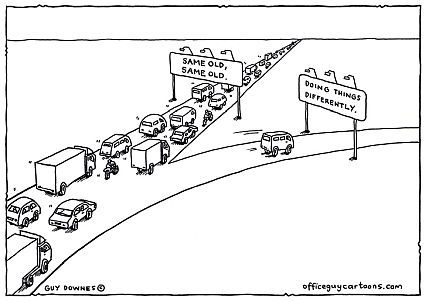Sometimes our success limits our thinking about what we could be achieving. We think we are doing well, but we really should be doing so much more.
I’ve written, often, about how we “settle” for win rates of 15-20% and are happy achieving our growth goals. While these organizations are hitting their targets, and sometimes with aggressive YoY scaling, they should be doing so much more! They could easily double revenue by doubling win rates to a mediocre 30-40%. Yet too many just keep doing what they have always done, failing to achieve their real potential. They seldom consider, “What might we achieve if we looked at doubling win rates? What does it take for us to do this?”
Recently, I looked at one very large company. In one region, they were achieving great results. In a similar, but different region, they were achieving a fraction of the results. The markets were very similar, the TAMs were similar, everything we looked at showed each region should be performing at roughly the same levels. When I asked the regional leader about the difference, he cited budget constraints. “I can only hire this many people, so I’m limited in how much I can grow.” (We’ll come back to this.)
Too often, our approach to driving growth is a scaling strategy. Scaling is simply that–scaling. It is doing more of what has always been done. We scale simply by doing the math. If each seller can produce $X in revenue, to meet our goals, we simply do the math, we divide our goal by average revenue per seller and we make sure we have enough sellers in place.
Alternatively, we establish our goals by running the trendlines based on past performance, perhaps boosting them a little. Then we do the same calculation, “How many people do we need to achieve this goal?”
What we miss is that we could/should be doing so much more–but our strategies of doing more of the same limit our ability to think about what we should be doing.
We seldom think, “What should we be doing differently? What can we change that would dramatically improve performance?”
Let’s go back to the case I mentioned above. The executive whose region might be doing so much more than what he was doing. I posed the question, “If I told you that within two years, you have to be matching the revenue performance of the other regions, what would you do differently? What would you need to achieve that goal?”
The reaction was amazing. He called me about a week later saying, “Dave, I have some ideas. Can we talk about them?” When we spoke about them, he had come up with a very new approach within his region. He hadn’t simply done the math to figure out how many sales people he needed, he had come up with a very new approach to achieving the new goals. We discussed what he would have to change, how he would do it, the new resources he would need, the risks and what he would do to mitigate those risks.”
I asked, “Have you ever presented something like what you are showing me to your management?”
He never had, because his management had never challenged him to think differently. But he sat down with the executive team, walking through his analysis and plan. There was a lot of back and forth, questions, some shifts in the strategy. In the end, he didn’t get everything he asked for, but he got more than he ever would have imagined. They settled on the goals and gave him the resources and support needed to achieve the goals.
As I’ve mentioned so often before, we become prisoners of our own experiences. At all levels, we tend to do more of what we’ve always done. When we do this and fail to achieve our goals, we know we have to change. But the real opportunity is applying the same thinking–even if we are already achieving our goals. At all levels, we can’t settle for scaling the status quo. We must always be thinking, about what might be possible. What might happen if we did things differently.

Leave a Reply